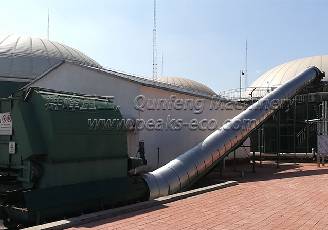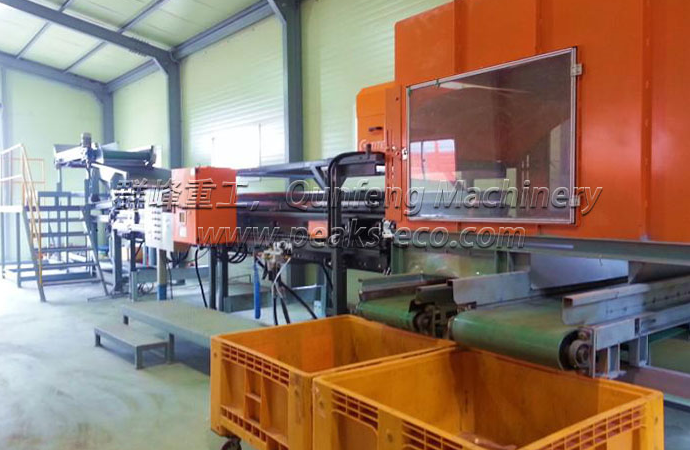Anaerobic digestion system process design mainly embodied in the digester type, mixing method and process on the choice of operating parameters.The general design principles are as follows: a) on the basis of reference to similar engineering cases and design specifications, the optimal process operation parameters, such as residence time, operating temperature, solid load and organic load, are obtained through experiments;B) suitable pool type selection;C) good mixing method, mixing evenly, no dead corners;D) simple and stable operation guarantee, such as equipment that is easy to operate and maintain, good heat transfer equipment that avoids temperature fluctuations, and measures to remove scum easily;E) safe and reliable biogas delivery system.
Content to be determined in process design: a) design of digestion mode;B) selection of digester shape;C) determine the mixing method of sludge in the digester;D) selection of design parameters;E) determination of sludge heating method;F) determination of sludge allocation method;G) determination of sludge and methane emission modes;H) removal method of scum and supernatant;I) guarantee of safety and protection measures;J) determination of monitoring and control methods;K) selection of other ancillary devices.Among the above aspects, the way of anaerobic digestion, the shape of the digester, the main design parameters and the mixing and mixing method of the sludge in the digester have great influence on the construction cost and use effect of the digester, which should be selected carefully.
1
The design of the digestion method
(1) digestion temperature, anaerobic digestion according to the operating temperature of different divided into medium temperature digestion (30 ~ 36℃) and high temperature digestion (50 ~ 55℃), in which the best temperature of medium temperature digestion is 35℃, the best temperature of high temperature digestion will be due to other factors will have a greater change.High temperature digestion is characterized by fast decomposition rate, high gas production rate and short residence time, thus improving the digestion capacity and saving the digester volume.In addition, the hygiene index was better, the killing rate of parasitic worm eggs could reach 95%, and the coliform index could reach 10-100.High energy consumption and difficult temperature control.The characteristics of medium-temperature digestion are that compared with the advantages of high-temperature digestion, the medium-temperature digestion is stable, easy to control, relatively low energy consumption, and has mature design and operation experience.At present, the domestic and external use of medium temperature anaerobic digestion.
(2) digestion level, according to the number of digestion tank divided into one digestion and two digestion.Primary digestion refers to sludge anaerobic digestion is completed in a digester;Two-stage digestion refers to the anaerobic digestion of sludge is completed in two digesters. The first-stage digester is equipped with heating, stirring device and gas collection device, and no supercleaning liquid and scum are discharged. The second-stage digester is not heated and stirred, and only the remaining heat of the first stage is used to continue digestion, and the supercleaning liquid and scum are discharged at the same time.The cost of the two-stage digestion process is relatively high, and the operation is more complicated than that of the first-stage digestion. The decomposition rate of organic matter is slightly improved, and the gas production rate is about 10% higher than that of the first-stage digestion.Based on the savings of investment costs and simple and stable operation, the current domestic use of a digestion.

Anaerobic Digestion Plant
2
Selection of anaerobic digestion plant
A standard digester should be characterized by good mixing and agitation, good scum foam removal conditions, good structural conditions, and no dead zone. There are many types of the digester, and there are three kinds of digester in common use. The three kinds of digester have their own advantages and disadvantages, which are suitable for different regions. The following simple description can provide a reference for the design.
The flat cylinder is more common in Europe, height: diameter = 1. This kind of flat - bottomed circular mixing system has a single requirement, and most of them adopt the hanging injection biogas mixing technology which can be installed at multiple points in the tank.
Cone bottom cylinder is widely used in China, where the height: diameter =1, the top and bottom are cones, the bottom slope is 1.0-1.7, and the top slope is 0.6-1.0. This type of digester is conducive to internal circulation, with less heat loss than the flat bottom cylinder, and a good mixing system. The disadvantage is that the bottom volume is large, easy to accumulate sand, need to be cleaned regularly. In addition, from the structural point of view, the cone part is difficult to construct, and the stress set, need special treatment.
The oval digester is an improvement on the cylindrical shape of the cone bottom. The shape of the digester has many advantages for the above two types of digesters.B) under certain pool capacity conditions, the total surface area of the pool body is small and the heat loss is small;C) small surface area on the top of the tank, easy to remove scum and easy to collect biogas;D) structurally, the egg-shaped structure bears good stress and saves building materials;E) beautiful appearance.

没有评论:
发表评论